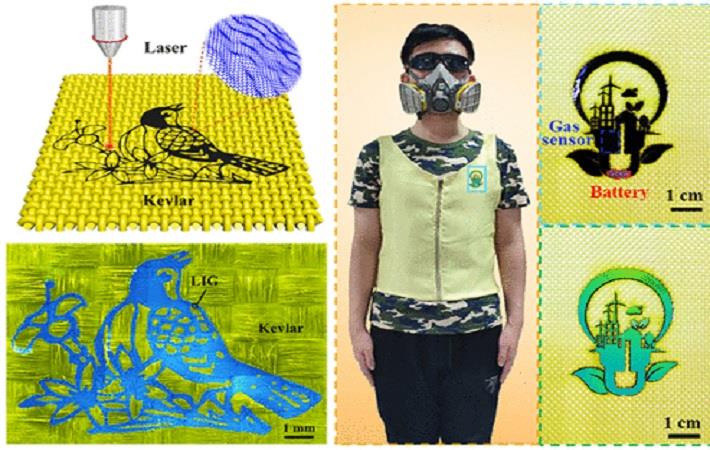A team at Beijing’s Tsinghua University has used lasers to make graphene-on-Kevlar textiles, creating protective clothing that can record the wearer’s electrocardiogram (ECG) or sense a toxic gas. Yingying Zhang and colleagues used a carbon dioxide laser to write on Kevlar, a synthetic polyamide fibre used to make body armour and personal protective clothing.
The laser burned and depolymerised the Kevlar fibres and the carbon atoms recombined to form graphene, as shown by Raman spectroscopy. Using a motorised set-up for the laser, the team was able to scribe any design on the textile in minutes.A team at Beijing's Tsinghua University has used lasers to make graphene-on-Kevlar textiles, creating protective clothing that can record the wearer's electrocardiogram or sense a toxic gas. Yingying Zhang and colleagues used a carbon dioxide laser to write on Kevlar, a synthetic polyamide fibre used to make body armour and personal protective clothing.#
The team used the technique to make a zinc-air battery, where one of the battery electrodes was the graphene-Kevlar textile coated with a cobalt oxide compound and the other electrode was zinc. Three such flexible batteries connected in series powered a green LED light on the fabric, which remained lit even when the fabric was flexed, according to a report on a website dedicated to chemical and engineering updates.
The graphene-Kevlar electrodes could also detect toxic nitrogen dioxide, sensing as little as 10 ppm with high selectivity. The team then combined the zinc-air batteries and the gas sensor to make a self-powered gas sensor textile. A fully-charged battery could provide power to the gas sensor for about 12 hours.
In addition, the team also showed a high quality ECG signal using the graphene-Kevlar electrode textile wrapped around a volunteer’s arm, useful for making protective clothing that is also capable of monitoring a person’s vitals in the field.
Fibre2Fashion News Desk (DS)


